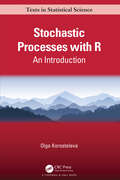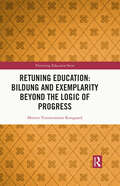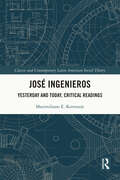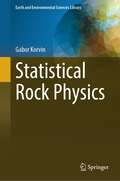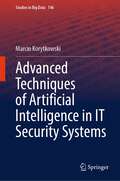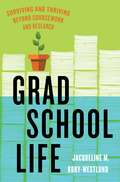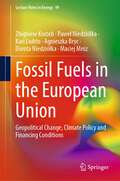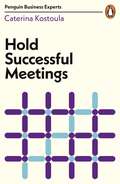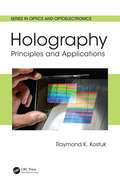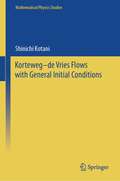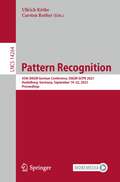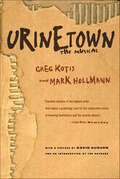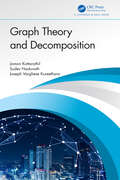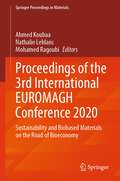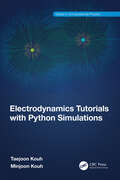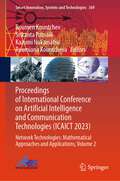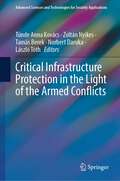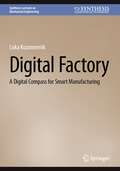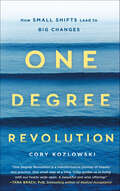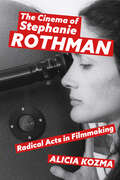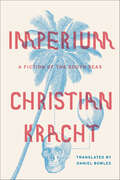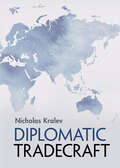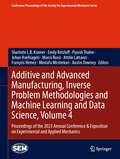- Table View
- List View
Stochastic Processes with R: An Introduction (Chapman & Hall/CRC Texts in Statistical Science)
by Olga KorostelevaStochastic Processes with R: An Introduction cuts through the heavy theory that is present in most courses on random processes and serves as practical guide to simulated trajectories and real-life applications for stochastic processes. The light yet detailed text provides a solid foundation that is an ideal companion for undergraduate statistics students looking to familiarize themselves with stochastic processes before going on to more advanced courses.Key Features Provides complete R codes for all simulations and calculations Substantial scientific or popular applications of each process with occasional statistical analysis Helpful definitions and examples are provided for each process End of chapter exercises cover theoretical applications and practice calculations
Retuning Education: Bildung and Exemplarity Beyond the Logic of Progress (ISSN)
by Morten Timmermann KorsgaardThis book responds to the need for new ways of defining the aims and forms of education, in an age that has seen the ideals of progress and growth lead the planet and its inhabitants to the brink of extinction.Arguing that contemporary ideas of performance and accountability counter "the heart" of education, the book calls for a retuning of education that encourages the younger generation to study objects and ideas for their own sake, rather than to appease established and conventional notions in society – therefore stepping into a common space of reflection and study. The chapters examine why and how we educate, and offer the alternative of engaging with educational questions, not determined by the logic of progress and growth but with an objective of creating a relation to the world around us. Using the works of Hannah Arendt combined with the tradition of Allgemeine Pädagogik to argue for a new conception of Bildung, the book encourages a method that emphasises outrospection over introspection.Ultimately questioning modern-day education, the book redirects and retunes education away from being wholly concerned with achievement and growth, and will therefore be of interest to students, researchers and academics in the fields of philosophy of education, education and curriculum studies, education policy and politics, and sociology of education.
José Ingenieros: Yesterday and Today, Critical Readings (Classic and Contemporary Latin American Social Theory)
by Maximiliano E. KorstanjeMaximiliano Korstanje presents an overview and analysis of the work of the Argentinian sociologist and physician, José Ingenieros (1877–1925). In fact, José Ingenieros was a seminal scholar who contributed directly to the formation of sociology in Latin America. Born in Palermo, Italy Ingenieros grew up in Buenos Aires, Argentina. He trained in medicine, psychiatry, sociology and philosophy; he devoted much of his life to addressing societal challenges such as mass migration, imperialism, marginality, criminality and social identity.Korstanje takes in turn the key areas of Ingenieros’s work and examines how his thinking can be brought to bear on the social challenges of today. In particular his work on mass migration and the “Other” have echoes in the problems facing many countries in the early twenty-first century. It is a valuable resource for scholars and students looking to better understand this key figure in Argentinian – and Latin American – sociology in the early twentieth century.
Statistical Rock Physics (Earth and Environmental Sciences Library)
by Gabor KorvinThe book is the first systematic and comprehensive treatise of stochastic models and computational tools that have emerged in rock-physics in the last 20 years. The field of statistical rock-physics is a part of rock-physics (Petrophysics). Its concepts, methods and techniques are borrowed from stochastic geometry and statistical physics. This discipline describes the interior geometry of rocks; derives their effective physical properties based on their random composition and the random arrangement of their constituents; and builds models to simulate the past geological processes that had formed the rock. The aim of the book is to help the readers to understand the claims, techniques and published results of this new field and—most importantly—to teach them in order to creatively apply stochastic geometry and statistical physics in their own research tasks. For this purpose, the underlying mathematics will be discussed in all sections of the book; numerical solutions will be highlighted; a full set of references will be provided; and theory will go hand-in-hand with practical applications to hydraulic permeability, electric conduction, rock failure, NMR, mechanics of random grain packings, as well as the compaction of shale.
Advanced Techniques of Artificial Intelligence in IT Security Systems (Studies in Big Data #146)
by Marcin KorytkowskiThe book explores how modern technologies, including artificial intelligence and neural networks, are being used to enhance cybersecurity. In today's world, the development of the Internet is nothing short of transformative, affecting every aspect of our lives. Ensuring the safety of its users is a paramount concern, and it requires a diverse set of disciplines to address. Researchers from various fields, including IT, mathematics, psychology, and medicine, are collectively working to tackle this interdisciplinary challenge. The significance of this issue has been magnified by the COVID-19 pandemic, which forced many aspects of our lives into the digital realm, from online payments to remote work and education. This shift brought new security challenges, with data privacy and system integrity taking center stage. It delves into the intricacies of Big Data by having to analyze an immense volume of network traffic data that can only be effectively analyzed with specialized tools. Real-time threat detection is critical, and the book sheds light on cutting-edge approaches to achieving this goal. The content of the book covers a broad spectrum of topics related to IT system security, from user and system profiling to preventing data leaks and defending against phishing attacks. Additionally, innovative concepts such as “glial networks” are introduced, offering new ways to interpret knowledge stored in convolutional networks. These solutions are not limited to security alone; they have applications across various domains. The book highlights the advantages of these cutting-edge approaches over existing methods, demonstrating their relevance to large corporations, public institutions, schools, small businesses, and households. In a world where security threats are constantly evolving, this book is a valuable resource for understanding the dynamic landscape of network security and the role of artificial intelligence in safeguarding our digital ecosystems.
Grad School Life: Surviving and Thriving Beyond Coursework and Research
by Jacqueline M. Kory-WestlundGrad school isn’t easy. It’s even less easy when you’re also managing a second job, a family, or depression—or when you are a first-generation student, or if you come from an underrepresented group or a lower socioeconomic-status background. Grad students are overworked, overstressed, and over it.Most grad school advice books focus on the professional side: finding funding, managing research and teaching, and applying for academic jobs. But students today face a difficult job market. Only a handful will obtain coveted tenure-track professorships, so they need alternative career prep. Plus, grad school is only one part of your life. And with an average age of 33 years, today’s students are juggling far more than school.That’s where this book comes in. It will help you keep up a personal life, make the most of your time, and prepare for your career—whether in academia or beyond. This pragmatic book explains how to persevere through the grad school long haul, covering challenges both on and off campus. It shares candid, specific advice on personal finances, mental health, setting your own learning and career goals, maintaining friendships and relationships, and more.Peppy, sensible, and smart, Grad School Life points out the pitfalls of academia and helps you build the life you want. With fresh insights, concrete suggestions and exercises, and helpful lists of resources, this book gives grad students a new roadmap for not only surviving but thriving—both in school and in the real world.
Fossil Fuels in the European Union: Geopolitical Change, Climate Policy and Financing Conditions (Lecture Notes in Energy #99)
by Zbigniew Korzeb Paweł Niedziółka Kari Liuhto Agnieszka Bryc Dorota Niedziółka Maciej MrózThis book identifies scenarios for changes in transmission infrastructure, contracting, consumption patterns and fossil fuel financing policies, considering climate goals and the consequences of the conflict in Ukraine. The invasion of Ukraine by the Russian Federation has fundamentally changed the geopolitical situation, approaches to energy security issues, the EU’s energy (in)dependence and the implementation of previously outlined climate policies, including the planned gradual withdrawal from fossil fuels.This book presents the geopolitical architecture, energy mix, energy fuel supply structure, long-term energy policy and financing conditions of the oil and gas and sectors in the EU in the period preceding and following the Russian invasion of Ukraine. The authors consider the date of Russia’s attack on Ukraine as a symbolic caesura marking the beginning of the process of creating a new energy order in the EU. A novel part of the book is the attention it pays to the role of the credit and investment policy of the EU banking sector in relation to carbon-intensive sectors and to the significance of the financial system from the point of view of the effectiveness of international sanctions imposed on the Russian Federation, including, above all, sanctions related to the fossil fuel sector. The book is of interest to researchers and all those interested in learning about these subjects.
Psychotherapie mit kognitiv-behavioraler Therapie und Hypnose: Die Praxisanleitung: Verhaltenstherapie effektiv kombiniert mit Hypnose (Psychotherapie: Praxis)
by Hans-Christian KossakDer Autor stellt als erfahrener Psychologischer Psychotherapeut die von ihm erprobte Therapiemethode vor, die als Kombination von moderner kognitiv-behavioraler Therapie und moderner Hypnose in der Psychotherapie, Medizin und Zahnmedizin bei zahlreichen Störungen, Erkrankungen und Problemstellungen sehr erfolgreich anzuwenden ist. Sie wirkt oft in wenigen Sitzungen und ist erwiesen sehr effektiv. Hier stellt der Autor sein Wissen und seine Erfahrung als Verhaltenstherapeut, Hypnosetherapeut und Gesprächspsychotherapeut zusammen. Entsprechend vermittelt er die Theorie und schwerpunktmäßig die praktischen Anwendungen mit zahlreichen Fallbeispielen klar und schnell nachvollziehbar. Geschrieben für: Anfänger und Praktiker im Bereich der kognitiv-behavioralen Therapie als auch in der klinischen Hypnose können zahlreiche Impulse für ihre Arbeit erhalten. Auch Studierende aus diesen klinischen Berufsbereichen erhalten Einblicke und wertvolle anschauliche Anregungen und Vorbilder zur Diagnostik, Therapieplanung und Therapiedurchführung dieser Methode.Über den Autor:Dr. Dipl.-Psych. Hans-Christian Kossak verfügt über 50 Jahre Berufserfahrung als Psychologischer Psychotherapeut (Verhaltenstherapeut, Gesprächspsychotherapeut, Hypnosetherapeut) und Dozent auf nationalen und internationalen Fachkongressen und in Fortbildungsseminaren. Er ist bekannt für seine praxisnahen Darstellungen und besonders für seine umfangreichen Erfahrungen, die er sehr plastisch vermitteln kann.
Hold Successful Meetings (Penguin Business Experts Series)
by Caterina KostoulaMeetings allow us to bring people together to inspire each other, solve problems and make a difference. Yet, we all spend too much time in dull, frustrating meetings where little is achieved and even less is followed up on afterwards. In Hold Successful Meetings, executive coach and former Google leader Caterina Kostoula will change all this. Her unique framework will:- Equip you to hold fewer, more purposeful meetings- Create a creative and inclusive environment- Leave participants inspired and ready to take actionWhether virtual or in-person, people will leave your meetings inspired by the value you created together and ready to make an impact.'I bought this for my whole team at Google!' Reader review
Holography: Principles and Applications (Series in Optics and Optoelectronics #7233)
by Raymond K. KostukThis self-contained treatment of the principles, techniques, and applications of holography examines theory and practice, image analysis, specialized techniques, and a range of applications of both analog and digital holographic methods. The author, an esteemed professor in the field, describes the nature of holographic and lithographic diffraction gratings and the tools necessary for their design and analysis. Suitable for researchers and graduate students in physics and optics, the book includes exercise problems to enhance understanding. Features Offers a systematic, rigorous account of the principles, techniques, and applications of holography Draws on the experience and lectures of a well-known author and professor in the field Presents the theory and applications of both analog and digital holographic methods Includes exercise problems
Korteweg–de Vries Flows with General Initial Conditions (Mathematical Physics Studies)
by Shinichi KotaniLarge numbers of studies of the KdV equation have appeared since the pioneering paper by Gardner, Greene, Kruskal, and Miura in 1967. Most of those works have employed the inverse spectral method for 1D Schrödinger operators or an advanced Fourier analysis. Although algebraic approaches have been discovered by Hirota–Sato and Marchenko independently, those have not been fully investigated and analyzed. The present book offers a new approach to the study of the KdV equation, which treats decaying initial data and oscillating data in a unified manner. The author’s method is to represent the tau functions introduced by Hirota–Sato and developed by Segal–Wilson later in terms of the Weyl–Titchmarsh functions (WT functions, in short) for the underlying Schrödinger operators. The main result is stated by a class of WT functions satisfying some of the asymptotic behavior along a curve approaching the spectrum of the Schrödinger operators at +∞ in an order of -(n-1/2)for the nth KdV equation. This class contains many oscillating potentials (initial data) as well as decaying ones. Especially bounded smooth ergodic potentials are included, and under certain conditions on the potentials, the associated Schrödinger operators have dense point spectrum. This provides a mathematical foundation for the study of the soliton turbulence problem initiated by Zakharov, which was the author’s motivation for extending the class of initial data in this book. A large class of almost periodic potentials is also included in these ergodic potentials. P. Deift has conjectured that any solutions to the KdV equation starting from nearly periodic initial data are almost periodic in time. Therefore, our result yields a foundation for this conjecture. For the reader’s benefit, the author has included here (1) a basic knowledge of direct and inverse spectral problem for 1D Schrödinger operators, including the notion of the WT functions; (2)Sato’s Grassmann manifold method revised by Segal–Wilson; and (3) basic results of ergodic Schrödinger operators.
Pattern Recognition: 45th DAGM German Conference, DAGM GCPR 2023, Heidelberg, Germany, September 19–22, 2023, Proceedings (Lecture Notes in Computer Science #14264)
by Ullrich Köthe Carsten RotherThis book constitutes the proceedings of the 45th Annual Conference of the German Association for Pattern Recognition, DAGM-GCPR 2023, which took place in Heidelberg, Germany, during September 19-22, 2023. The 40 full papers included in these proceedings were carefully reviewed and selected from 76 submissions. They were organized in topical sections as follows: Segmentation and action recognition; 3D reconstruction and neural rendering; Photogrammetry and remote sensing; Pattern recognition in the life sciences; Interpretable machine learning; Weak supervision and online learning; Robust models.
Urinetown: The Musical
by Greg Kotis Mark HollmannWinner of three Tony Awards, including Best Book, Greg Kotis and Mark Hollmann's Urinetown: The Musical is a tale of greed, corruption, love, and revolution in a time when water is worth its weight in gold.After a twenty-year drought made water a scarce commodity, private toilets became outlawed. Now, all restroom necessaries are controlled by the Urine Good Company (UGC), a megacorporation that charges fees for using public toilets. Anyone unable to pay fees--or who dares to relieve themselves outside the commode--are arrested and banished to "Urinetown".When UGC employee Bobby Strong's father falls victim to this tyranny, he spearheads a revolution, inspiring the people to rise up and reclaim their own restroom duties--unaware of the realities and consequences of his actions...With a preface by David Auburn, Pulitzer Prize-winning playwright of ProofAnd an introduction by the authors
Graph Theory and Decomposition
by Jomon Kottarathil Sudev Naduvath Joseph Varghese KureetharaThe book Graph Theory and Decomposition covers major areas of the decomposition of graphs. It is a three-part reference book with nine chapters that is aimed at enthusiasts as well as research scholars. It comprehends historical evolution and basic terminologies, and it deliberates on decompositions into cyclic graphs, such as cycle, digraph, and K4-e decompositions. In addition to determining the pendant number of graphs, it has a discourse on decomposing a graph into acyclic graphs like general tree, path, and star decompositions. It summarises another recently developed decomposition technique, which decomposes the given graph into multiple types of subgraphs. Major conjectures on graph decompositions are elaborately discussed. It alludes to a comprehensive bibliography that includes over 500 monographs and journal articles. It includes more than 500 theorems, around 100 definitions, 56 conjectures, 40 open problems, and an algorithm. The index section facilitates easy access to definitions, major conjectures, and named theorems.Thus, the book Graph Theory and Decomposition will be a great asset, we hope, in the field of decompositions of graphs and will serve as a reference book for all who are passionate about graph theory.
Proceedings of the 3rd International EUROMAGH Conference 2020: Sustainability and Biobased Materials on the Road of Bioeconomy (Springer Proceedings in Materials #43)
by Ahmed Koubaa Nathalie Leblanc Mohamed RagoubiThis conference proceeding presents selected manuscripts from the EUROMAGH 2020 Conference entitled “Sustainability and Biobased Materials on the Road of Bioeconomy”. The content highlights technical progress and recent knowledge in the valorization of biomass into biobased materials, from extraction of natural polymers, biopolymers, to biobased mixtures from macro to nano scales. Topics include the following but not limited to: 1. Agroresources, fibers, nanofibers and nanoparticles reinforcements 2. Biocomposites and Nano biocomposites 3. Rheology, Bioprocess and Modeling 4. Plant aggregates, vegetal concrete and Industrial valorisation
Electrodynamics Tutorials with Python Simulations (Series in Computational Physics)
by Taejoon Kouh Minjoon KouhThis book provides an accessible introduction to intermediate-level electrodynamics with computa- tional approaches to complement a traditional mathematical treatment of the subject. It covers key topics in electrodynamics, such as electromagnetic fields, forces, potentials, and waves as well as Special Theory of Relativity.Through intuition-building examples and visualizations in the Python programming language, it helps readers to develop technical computing skills in numerical and symbolic calculations, modeling and simulations, and visualizations. Python is a highly readable and practical programming language, making this book appropriate for students without extensive programming experience.This book can serve as an electrodynamics textbook for undergraduate physics and engineering students in their second or third years, who are studying intermediate- or advanced-level electrodynamics and who want to learn techniques for scientific computing at the same time. This book will also appeal to computer science students who want to see how their computer programming skills may be applied to science, particularly to physics, without needing too much background physics knowledge.Key features• Major concepts in classical electrodynamics are introduced cohesively through computational and mathematical treatments.• Computational examples in Python programming language guide students on how to simulate and visualize electrodynamic principles and phenomena for themselves.Taejoon Kouh is a Professor of Nano and Electronic Physics at Kookmin University, Republic of Korea. He earned his B.A. in physics from Boston University and Sc.M. and Ph.D. degrees in physics from Brown University. After his study in Providence, RI, he returned to Boston, MA, and worked as a postdoctoral research associate in the Department of Aerospace and Mechanical Engineering at Boston University. He is a full faculty member in the Department of Nano and Electronic Physics at Kookmin University in Seoul, Korea, teaching and supervising undergraduate and graduate students. His current research involves the dynamics of nanoelectromechanical systems and the development of fast and reliable transduction methods and innovative applications based on tiny motion.Minjoon Kouh is a program scientist for a philanthropic initiative. He was a Professor of Physics and Neuroscience at Drew University, USA, where he taught more than 30 distinct types of courses. He holds Ph.D. and B.S. degrees in physics from MIT and an M.A. from UC Berkeley. He completed a postdoctoral research fellowship at the Salk Institute for Biological Studies in La Jolla, CA. His research includes computational modeling of the primate visual cortex, information-theoretic analysis of neural responses, machine learning, and pedagogical innovations in undergraduate science education.
Proceedings of International Conference on Artificial Intelligence and Communication Technologies: Network Technologies: Mathematical Approaches and Applications, Volume 2 (Smart Innovation, Systems and Technologies #369)
by Roumen Kountchev Srikanta Patnaik Kazumi Nakamatsu Roumiana KountchevaThis book contains selected papers presented at the International Conference on Artificial Intelligence and Communication Technologies (ICAICT'23), held at Shenzhen, China in June 2023. This second volume of the proceedings is focused on new methods, algorithms and mathematical approaches, developed on the basis of Deep Learning and Artificial Intelligence, with various applications in information security, efficient power management, multimedia, and many others.
Critical Infrastructure Protection in the Light of the Armed Conflicts (Advanced Sciences and Technologies for Security Applications)
by Tünde Anna Kovács Zoltán Nyikes Tamás Berek Norbert Daruka László TóthThis book summarizes the latest findings in critical infrastructure protection and related research areas. Armed conflicts and wars are now closer to Europe than at any time in the last several decades, and the protection of critical infrastructures has gained new prominence. This situation has also revealed the vulnerability of critical infrastructure and the importance of its protection. The development of technologies, cybertechnologies, and digitalization in all aspects of our daily lives implies new security challenges in critical infrastructure protection and security science and this book addresses the four main dimensions of critical infrastructure protection: 1. Physical protection 2. Cybersecurity 3. Political security 4. Individual security The issue of physical security has accompanied humanity since its birth. Nowadays, this issue has become even more important due to technological advances, as this is the security area that people physically experience—physical protection, including protection against explosions and ballistic attacks, but also defense of objects and guaranteeing transportation security. Cyberspace represents the fifth domain of warfare and a central security question in our age. The base of cyberspace defense is high-quality hardware and expert support. With our lives increasingly digital, cybersecurity's core elements include safety awareness and informatics. Political security, the third dimension, is shaped by diverse political ideologies influencing economies, societies, and other aspects of life. This book explores topics such as migration policies, defense against terrorism, national and international security, and public safety.The fourth dimension, individual security, spans healthcare, food safety, energy supplies, and economic security. Each chapter of this book emphasizes security, focusing on Central Europe while addressing global concerns. Authored by researchers, experts, and scholars, this book is invaluable for Ph.D. students, professionals, and educators worldwide.The fourth dimension, individual security, spans healthcare, food safety, energy supplies, and economic security. Each chapter of this book emphasizes security, focusing on Central Europe while addressing global concerns. Authored by researchers, experts, and scholars, this book is invaluable for Ph.D. students, professionals, and educators worldwide. The fourth dimension, individual security, spans healthcare, food safety, energy supplies, and economic security. Each chapter of this book emphasizes security, focusing on Central Europe while addressing global concerns. Authored by researchers, experts, and scholars, this book is invaluable for Ph.D. students, professionals, and educators worldwide. The fourth dimension, individual security, spans healthcare, food safety, energy supplies, and economic security. Each chapter of this book emphasizes security, focusing on Central Europe while addressing global concerns. Authored by researchers, experts, and scholars, this book is invaluable for Ph.D. students, professionals, and educators worldwide. The fourth dimension, individual security, spans healthcare, food safety, energy supplies, and economic security. Each chapter of this book emphasizes security, focusing on Central Europe while addressing global concerns. Authored by researchers, experts, and scholars, this book is invaluable for Ph.D. students, professionals, and educators worldwide. The fourth dimension, individual security, spans healthcare, food safety, energy supplies, and economic security. Each chapter of this book emphasizes security, focusing on Central Europe while addressing global concerns. Authored by researchers, experts, and scholars, this book is invaluable for Ph.D. students, professionals, and educators worldwide. The fourth dimension, individual security, spans healthcare, food safety
Digital Factory: A Digital Compass for Smart Manufacturing (Synthesis Lectures on Mechanical Engineering)
by Luka KozamernikThe Digital Factory is a comprehensive guide for leaders in the manufacturing sector looking to navigate the complex digital transformation landscape. Digitalization has become crucial to any company's success in today's fast-paced business world. However, making sense of the plethora of information on approaching digitalization can be challenging, leaving many leaders needing clarification. The pressure to make the right decisions can be overwhelming, with various groups advocating their interests. Without a clear vision and understanding of digital transformation, leaders may lack confidence in making the right company decisions. And with access to specific and valuable knowledge about digital transformation, achieving optimal returns for the company can be more accessible. This book is designed to empower leaders in the manufacturing sector to overcome these challenges.
One Degree Revolution: How Small Shifts Lead to Big Changes
by Coby KozlowskiInnovative, accessible, and easily implemented, One Degree Revolution is acclaimed yoga educator and leadership coach Coby Kozlowski's holistic program for self-inquiry and personal transformation. Her philosophy is deeply connected to living yoga—not just doing yoga. In fact, readers don’t need to have ever attended a yoga class to dive into this book: her thoughtful teachings are for anybody interested in learning to navigate the waves of life more skillfully and gracefully. Imagine sailing a boat with a course set for a lifetime. If that route changes by just one navigational degree, what would happen to the journey? How far from the original trajectory would we be in one year? Five years? Ten years? Twenty years? Well, we would end up in a totally different place. In much the same way, we can change the course of our life by making a one degree shift. In other words, we don’t have to change everything about ourselves or our world to make a difference.Coby inspires readers to dig deep, to ask powerful questions and to dive into the insights, experiments, and inquiries of living yoga: how can I best be with life? How can the teachings of yoga direct us to see the most aligned choices, let go of past hurts, and discover deep and meaningful connections? And what are the most skillful ways we can learn to savor all that life presents? These yoga philosophies are infused with practical strategies for creating the life you truly want and having a positive impact on the world. One Degree Revolution will guide readers to:-access infinite personal possibilities-celebrate their authentic selves and start listening to their calling-find meaning and purpose-learn to let go and trust the unfolding of life-value taking a pause and making a fresh start when needed-challenge long-held beliefs and foster transformational change-get comfortable with being uncomfortable, and-develop their communityOne degree at a time.
The Cinema of Stephanie Rothman: Radical Acts in Filmmaking
by Alicia KozmaThe rare woman director working in second-wave exploitation, Stephanie Rothman (b. 1936) directed seven successful feature films, served as the vice president of an independent film company, and was the first woman to win the Directors Guild of America’s student filmmaking prize. Despite these career accomplishments, Rothman retired into relative obscurity. In The Cinema of Stephanie Rothman: Radical Acts in Filmmaking, author Alicia Kozma uses Rothman’s career as an in-depth case study, intertwining historical, archival, industrial, and filmic analysis to grapple with the past, present, and future of women’s filmmaking labor in Hollywood. Understanding second-wave exploitation filmmaking as a transitory space for the industrial development of contemporary Hollywood that also opened up opportunities for women practitioners, Kozma argues that understudied film production cycles provide untapped spaces for discovering women’s directorial work. The professional career and filmography of Rothman exemplify this claim. Rothman also serves as an apt example for connecting the structure of film histories to the persistent strictures of rhetorical language used to mark women filmmakers and their labor. Kozma traces these imbrications across historical archives. Adopting a diverse methodological approach, The Cinema of Stephanie Rothman shines a needed spotlight on the problems and successes of the memorialization of women’s directorial labor, connecting historical and contemporary patterns of gendered labor disparity in the film industry. This book is simultaneously the first in-depth scholarly consideration of Rothman, the debut of the most substantive archival materials collected on Rothman, and a feminist political intervention into the construction of film histories.
Imperium: A Fiction of the South Seas
by Christian KrachtAn outrageous, fantastical, uncategorizable novel of obsession, adventure, and coconuts In 1902, a radical vegetarian and nudist from Nuremberg named August Engelhardt set sail for what was then called the Bismarck Archipelago. His destination: the island Kabakon. His goal: to found a colony based on worship of the sun and coconuts. His malnourished body was found on the beach on Kabakon in 1919; he was forty-three years old. Christian Kracht's Imperium uses the outlandish details of Engelhardt's life to craft a fable about the allure of extremism and its fundamental foolishness. Engelhardt is at once a sympathetic outsider—mocked, misunderstood, physically assaulted—and a rigid ideologue, and his misguided notions of purity and his spiral into madness presage the horrors of the mid-twentieth century. Playing with the tropes of classic adventure tales like Treasure Island and Robinson Crusoe, Kracht's novel, an international bestseller, is funny, bizarre, shocking, and poignant—sometimes all on the same page. His allusions are misleading, his historical time lines are twisted, his narrator is unreliable—and the result is a novel that is also a mirror cabinet and a maze pitted with trapdoors. Both a provocative satire and a serious meditation on the fragility and audacity of human activity, Imperium is impossible to categorize, and utterly unlike anything you've read before.
Diplomatic Tradecraft
by Nicholas KralevAs universities and governments seek to prepare the next generation of diplomats to manage international affairs, they finally have a teaching tool focusing on the practical knowledge and skills that in the past could be learned only on the job. Edited by Nicholas Kralev, founder of the Washington International Diplomatic Academy, Diplomatic Tradecraft brings together 18 career ambassadors with decades of experience to lift the curtain on a mysterious but vital profession, and to pass on the insights and abilities they gained to those who will succeed them. Beginning with an overview of diplomatic institutions and protocols, the text considers the key attributes of diplomatic communication and negotiation, as well as core specializations including economic, consular and public diplomacy. With compelling narratives, case studies and exercise scenarios, the chapters on various aspects of diplomatic practice form a cohesive and comprehensive volume, written in an accessible and engaging style.
Additive and Advanced Manufacturing, Inverse Problem Methodologies and Machine Learning and Data Science, Volume 4: Proceedings of the 2023 Annual Conference & Exposition on Experimental and Applied Mechanics (Conference Proceedings of the Society for Experimental Mechanics Series)
by Sharlotte L. B. Kramer Emily Retzlaff Piyush Thakre Johan Hoefnagels Marco Rossi Attilio Lattanzi François Hemez Mostafa Mirshekari Austin DowneyAdditive and Advanced Manufacturing, Inverse Problem Methodologies and Machine Learning and Data Science, Volume 4 of the Proceedings of the 2023 SEM Annual Conference & Exposition on Experimental and Applied Mechanics, the fourth volume of five from the Conference, brings together contributions to this important area of research and engineering. The collection presents early findings and case studies on a wide range of topics and includes papers in the following general technical research areas: AM Composites and Polymers Dynamic Behavior of Additively Manufactured Materials and Structures Joint Residual Stress and Additive Manufacturing ML for Material Model Identification Novel AM Structures Novel Processing and Testing of Additively Manufactured Materials Plasticity and Complex Material Behavior Virtual Fields Method
Sex and Shopping: An Autobiography
by Judith KrantzDear Reader, As I was about to start my eleventh novel, I abruptly realized that I was making a huge mistake. On the verge of launching into the imagined world of a twenty-eight-year-old, I felt an intense need to tell another story, the story of a woman I know through and through...a woman with more wealth of experience, a woman who's seen more real glamour, known more fascinating people, lived in a world of more sophistication, and arrived at more hard-won maturity than that twenty-eight-year-old could hope for---in short, my own story. I've tried to remain as unknowable as possible, the better to let my heroines hold the stage, but now I was ready to tell the truth about myself, with no holding back. I've had a different life from that of the majority of women of my generation and background. While I seemed like another "nice Jewish girl," underneath that convenient cover I'd traveled my own, inner-directed path and had many a spicy and secret adventure. I grew up in a complicated tangle of privilege, family problems, and tormented teenaged sexuality. After a riotous education at Wellesley, my life was turned upside down by a glorious year in Paris, marked by an intense but ill-starred romance. I spent the next half-decade in New York, sowing lighthearted wild oats until I finally met my true love, to whom I've been married for forty-six years.When I was fifty I had an utterly unexpected, almost unbelievable success as a number-one bestselling novelist that has continued for book after book. Challenging, lucky, exciting, and often devastatingly askew, my life seems to have been lived under a wild and antic star.I've had as much amazing fun as my heroines, and here's the book to prove it. Judith Krantz
